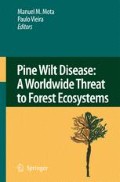Abstract
Five-month old seedlings and three-year old Pinus densiflora were used to examine histopathological damage of wood tissues and symptomatic progress of seedlings at established intervals after the inoculation with the pinewood nematode. At the inoculation site, nematodes entered most axial resin canals of the cortex and xylem resulting in destruction of parenchyma cells. Just after inoculation, only a few nematodes were found in the resin canals in the cortex, and beyond the inoculation site. Cell death recognized by granulation of the cytoplasm and brown cell contents were sporadically observed among axial and radial xylem parenchyma cells through the stem as early as 3 days after inoculation. At the sixth day after inoculation, death of axial and ray parenchyma cells of seedlings which showed the typical disease symptom – marked reduction of oleoresin exudation – was widely distributed in the stem. At this stage, no population growth of nematodes was observed throughout the seedling and no destruction of parenchyma cells necessarily occurred in wood tissues. After complete stop of oleoresin exudation in the seedling, destruction of wood tissues, such as parenchyma cells of axial and radial resin canals, ray, cambium and phloem became more advanced as nematode populations grew rapidly in wood of the seedling. Cell death occurring at the initial stage of pathogenesis was indicated as one of the most remarkable pathological progresses of the nematode inoculated seedling. Destruction of wood tissues resulted from nematode feeding on parenchyma cells following disease progress.
Access this chapter
Tax calculation will be finalised at checkout
Purchases are for personal use only
Preview
Unable to display preview. Download preview PDF.
References
Fukuda, K. (1997). Physiological process of the symptom development and resistance mechanism in pine wilt disease. Journal of Forest Research 2: 171–181.
Fukuda, K. Hogetsu, T. and Suzuki, K. (1992). Cavitation and cytological changes in xylem of pine seedlings inoculated with virulent and avirulent isolates of Bursaphelenchus xylophilus and B. mucronatus. Journal of the Japanese Forestry Society 74: 289–299.
Hara, N. and Futai, K. (2001). [Histological changes in xylem parenchyma cells and the effects of tracheids of Japanese black pine inoculated with pine wood nematode, Bursaphelenchus xylophilus.] Journal of the Japanese Forestry Society 83: 285–289.
Hara, N., Takeuchi, Y. and Futai, K. (2006). Cytological changes in ray parenchyma cells of seedlings of three pine species infected with the pine wilt disease. Japanese Journal of Nematology 36: 23–32.
Ichihara, Y., Fukuda, K. and Suzuki, K. (2000). Early symptom development and histological changes associated with the migration of Bursaphelenchus xylophilus in seedling tissues of Pinus thunbergii. Plant Disease 84: 675–680.
Ishida, K., Hogetsu, T., Fukuda, K. and Suzuki, K. (1993). Cortical response in Japanese black pine to attack by the pine wood nematode. Canadian Journal of Botany 71: 1399–1405.
Mamiya, Y. (1974). [Population increase of Bursaphelenchus lignicolus in wood of pine seedlings in relation with the time after inoculation.] Transactions of 85th Meeting of the Japanese Forestry Society: 249–251.
Mamiya, Y. (1975). [Behavior of Bursaphelenchus lignicolus in wood of pine seedlings and pathological responses of pine to nematode infection.] Transactions of 86 th Meeting of the Japanese Forestry Society: 285–286.
Mamiya, Y. (1980). [Inoculation of the first year pine (Pinus densiflora) seedlings with Bursaphelenchus lignicolus and the histopathology of diseased seedlings.] Journal of the Japanese Forestry Society 62: 176–183.
Mamiya, Y. (1982). Pine wilt and the pine wood nematode: histopathological aspects of disease development. In Resistance to diseases and pests in forest trees (eds. H.M. Heybroek, B.R. Stephan and K. von Weissenberg), pp. 153–160. Center for Agricultural Publishing and Documentation, Wageningen, The Netherlands.
Mamiya, Y. (1984). Behavior of the pine wood nematode, Bursaphelenchus xylophilus, associated with the disease development of pine wilt. In Proceedings of the United States-Japan Seminar, The resistance mechanisms of pines against pine wilt disease (ed. V. Dropkin), pp. 14–25. East-West Center, Honolulu, Hawaii.
Mamiya, Y. (1985). Initial pathological changes and disease development in pine trees induced by the pine wood nematode, Bursaphelenchus xylophilus. Annals of the Phytopathological Society of Japan 51: 546–555.
Mamiya, Y. and Kiyohara, T. (1972). Description of Bursaphelenchus lignicolus n. sp. (Nematoda: Aphelenchoididae) from pine wood and histopathology of nematode infested trees. Nematologica 18: 120–124.
Myers, R.F. (1986) Cambium destruction in conifers caused by pinewood nematodes. Journal of Nematology 18: 398–402.
Sugawa, T. (1979). [Occurrence of traumatic resin canals in the stem of Japanese black pine seedlings suffered from pine wood nematode (Bursaphelenchus lignicolus).] Journal of the Japanese Forestry Society 60: 460–463.
Author information
Authors and Affiliations
Editor information
Editors and Affiliations
Rights and permissions
Copyright information
© 2008 Springer Science+Business Media B.V.
About this chapter
Cite this chapter
Mamiya, Y. (2008). Histopathological Observations of Bursaphelenchus xylophilus in Symptomatic Tissues of Pinewood. In: Mota, M.M., Vieira, P. (eds) Pine Wilt Disease: A Worldwide Threat to Forest Ecosystems. Springer, Dordrecht. https://doi.org/10.1007/978-1-4020-8455-3_27
Download citation
DOI: https://doi.org/10.1007/978-1-4020-8455-3_27
Publisher Name: Springer, Dordrecht
Print ISBN: 978-1-4020-8454-6
Online ISBN: 978-1-4020-8455-3
eBook Packages: Biomedical and Life SciencesBiomedical and Life Sciences (R0)

